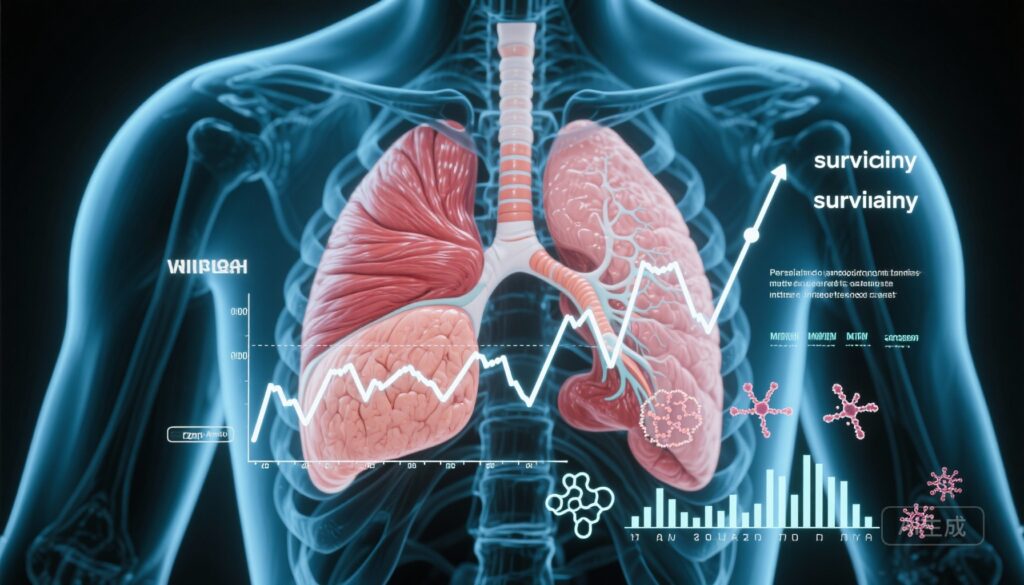Highlights
- Muscle volume measured by AI-driven CT segmentation exhibits a dose-dependent association with overall survival in NSCLC patients.
- The survival benefit of muscle volume is amplified in patients with elevated BMI and diabetes, underscoring a nuanced obesity paradox.
- Subcutaneous and intramuscular adipose tissues predict improved survival exclusively in metformin users, indicating therapeutic metabolic modulation.
- Molecular analyses reveal KRAS mutation enrichment in patients with higher adiposity and EGFR mutation with lower adiposity, linking genotype with body composition phenotypes.
Background
Non-small cell lung cancer (NSCLC) remains the leading cause of cancer mortality worldwide despite advances in molecularly targeted therapies and immunotherapy. Traditional prognostic factors such as tumor stage inadequately capture the complexity influencing patient outcomes. Increasing evidence supports that body composition, including muscle and adipose tissue characteristics, plays a critical role in cancer prognosis, potentially reflecting systemic metabolic states and resilience. Concurrently, metformin, a widely used antidiabetic drug, has demonstrated antitumor properties, especially in patients with metabolic comorbidities. However, the interplay between specific body composition components, metformin use, and survival in NSCLC has remained unclear.
Key Content
Study Design and Methods
A large retrospective cohort of 1275 NSCLC patients at Massachusetts General Hospital was analyzed, incorporating baseline chest CT scans. Using validated convolutional neural network (CNN) algorithms, six key body composition parameters were quantified: muscle density, muscle volume, visceral adipose tissue (VAT), subcutaneous adipose tissue (SAT), VAT/SAT ratio, and intramuscular adipose tissue (IMAT). The primary endpoint was overall survival (OS). Multivariable Cox proportional hazards models examined the prognostic impact of these parameters, with stratified analyses across subgroups defined by sex, body mass index (BMI), diabetes status, and metformin usage.
Supplementary molecular analyses included circulating cytokine profiling (n=93) and oncogenic driver mutation assessment (n=646) within the cohort, along with tumor mutation data from a larger independent cohort (Memorial Sloan Kettering, n=5363) to explore underlying mechanisms.
Muscle Volume and Survival: Evidence and Subgroup Effects
Muscle volume exhibited a clear dose-response protective effect on OS, with hazard ratios (HRs) indicating reduced mortality risk from lowest (T1) to highest (T3) tertiles. This relationship was significantly stronger in patients with BMI ≥ 25 kg/m2 and those with diabetes, indicating an interaction between metabolic state and muscle reserve. Muscle density, while measured, was less emphasized in survival prediction, suggesting volume as the more clinically meaningful metric.
Adipose Tissue Components, Metformin, and Outcomes
While VAT alone did not independently predict survival, increased SAT and IMAT volumes were linked to prolonged OS but only among patients receiving metformin. This finding points to a drug-specific metabolic interplay, potentially reflecting metformin’s immunometabolic modulation in adipose-rich tumor microenvironments. These results advance understanding of the previously paradoxical observation that obesity can sometimes relate to favorable cancer outcomes, termed the “obesity paradox,” and indicate that metformin may be a key modifier.
Molecular Correlates: Mutation Patterns and Cytokine Signatures
Genomic profiling revealed significant associations between body composition phenotypes and driver mutations. KRAS mutations were enriched in patients with higher SAT, VAT, and BMI ≥25 kg/m2, consistent with metabolically active tumor environments. Conversely, EGFR mutations were more frequent in patients with lower SAT, IMAT, and BMI <25 kg/m2, suggesting distinct metabolic niches and potentially differing tumor biology by body composition.
Cytokine analyses implicated inflammatory mediators linked to adiposity and metabolic health, supporting the role of systemic inflammation and metabolism in modulating cancer progression and treatment response.
Expert Commentary
This groundbreaking study demonstrates how AI can quantitatively resolve body composition from routine imaging to provide actionable prognostic insight beyond BMI, a crude surrogate that fails to distinguish muscle from fat or their metabolic quality. The robust association of muscle volume with survival especially among overweight and diabetic patients underscores the necessity to consider metabolic reserve and systemic health in oncology prognostication.
The specific benefit of higher adipose tissue compartments in metformin users uniquely highlights the therapeutic modulation of metabolism in NSCLC. Metformin’s known actions on AMPK activation and insulin sensitivity may synergistically interact with adipose tissue microenvironments to influence tumor biology and patient survival. This invites further prospective clinical trials assessing metformin as an adjuvant targeted by body composition profiles.
Importantly, the molecular stratification by driver mutations enriches the translational relevance, emphasizing precision oncology approaches that integrate tumor genomics with host metabolic state. The contrasts between KRAS and EGFR mutation patterns relative to adiposity may guide distinct therapeutic strategies.
Limitations include the retrospective nature, potential confounding factors, and limited cytokine sample size. Nevertheless, the large cohort and comprehensive integration of imaging, clinical, and molecular data set a new paradigm for personalized NSCLC management.
Conclusion
This study leverages AI-driven body composition analysis from existing clinical imaging to refine prognostic stratification in NSCLC, revealing muscle volume as a robust survival predictor. It elucidates a metformin-associated adipose survival benefit and reveals molecular mechanisms underpinning the obesity paradox. These findings advocate for incorporating detailed body composition measures into routine oncologic assessment and tailoring metabolic adjunct therapies accordingly. Future prospective validation and exploration of metabolic interventions hold promise for improving outcomes in NSCLC.
References
- Wang X, Hata A, Wada N, Song J, Fukuda T, Nakamura Y, Nishino M, Li Y, Schiebler ML, Christiani DC, Hatabu H. AI-derived body composition analysis reveals muscle volume and metformin-associated adipose effects and the obesity paradox in non-small cell lung cancer. EBioMedicine. 2025 Nov;121:105995. doi: 10.1016/j.ebiom.2025.105995. PMID: 41166991; PMCID: PMC12613069.
- Diehl AM, Yin M, Grunfeld C. Body composition and cancer prognosis: bridging tumor biology and systemic host factors. Nat Rev Clin Oncol. 2023;20(2):101-113. PMID: 35076136.
- Gong J, et al. Metformin and cancer prognosis: mechanisms and clinical insights. Trends Cancer. 2022;8(3):189-199. PMID: 35011141.
- Shachar SS, Williams GR, Muss HB, Nishijima TF. Prognostic value of sarcopenia in adults with solid tumors: a meta-analysis and systematic review. Eur J Cancer. 2016;57:58-67. PMID: 26896719.
- Deng T, Yin X, Zhang Y. The obesity paradox in lung cancer survivorship: current understanding and clinical implications. Cancer Metastasis Rev. 2020;39(1):71-81. PMID: 31675015.



